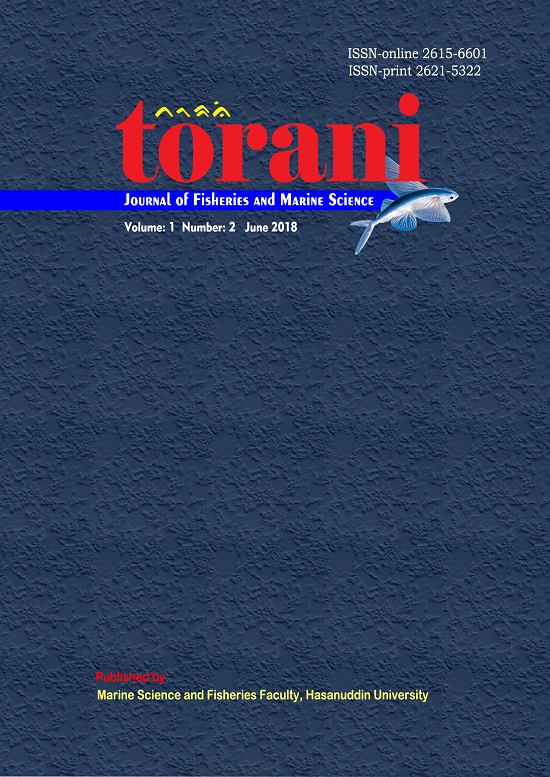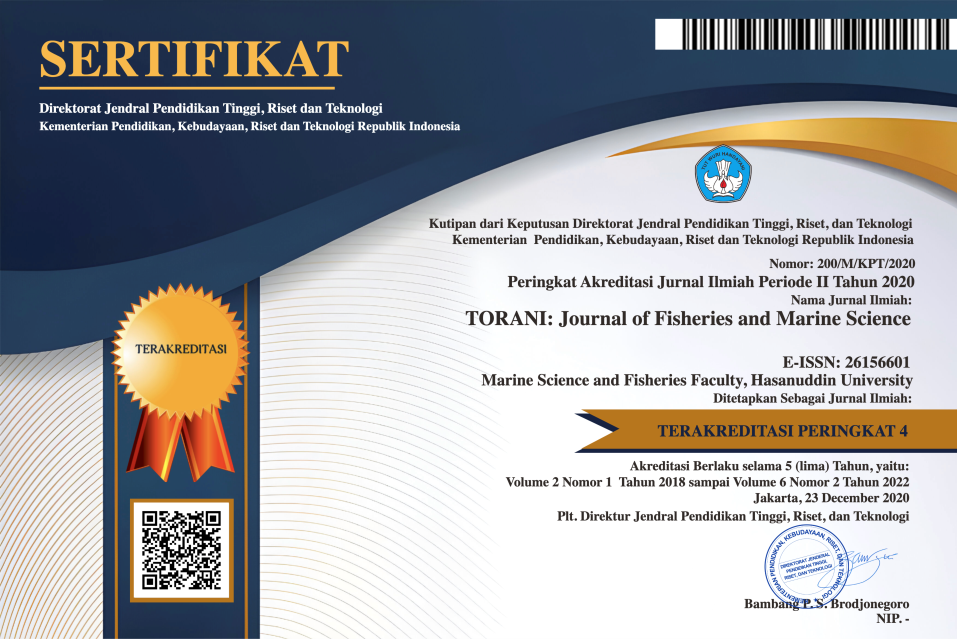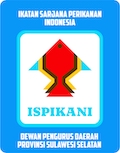Marine/Fisheries Resource Using (Case Study Ternate Manucipality, North Molucca)
DOI:
https://doi.org/10.35911/torani.v1i2.4511Abstract
This research was conducted to know study of marine/fishery resource utilization at Ternate Manucipality, North Molucca when It was carried out at December, 2015 . Method of research was included qualitative descripted method. Research resulting showed that North Molucca has been contributed to export of fishery result which Ternate Manucipality had fisheries potential prospect for developing. Net working trading fresh and fickle fisheries in Ternate started fishermen to small and middle traider. If fresh fisheries was resulted, they would be brought to Manado to process and export later, while resulting of marine product was started from middle traider in Ternate to Tiongkok descent at Makassar and Surabaya that it were exported to the purpose of countries.
Keywords: Fisheries resource, net working traiding, marine/fisheries fresh/fickle
References
Agus, A., dan Sudirman. 2005. Eksploitasi Ikan Sunu Hidup di Perairan Kepulauan Takabonerate, Kabupaten Selayar. Sulawesi Selatan. Jurnal Ecocelebica, 1 (3) : 196-205.
Agus, A., Nagatsu, K., Akamine, J., dan Kaneda, N. 2011. Masyarakat Maritime di Pesisir Timur Sulawesi Tengah. Jurnal Sorihi. 1 (3) : 57-65.
Agus, A., Tanaka, K., Shimizu, H., Kono, Y., dan Nagatsu, K. 2013. Masyarakat Pesisir di Maluku Utara. Jurnal Humano. 5 (2) : 137-146.
Akamine, J, 2009a. Challenging “boom and bust” market pressures: Development of self-managed sea cucumber conservation in Rishiri Island, Hokkaido, Japan. Biosphere Conservation. 9 (2) : 1-12.
Akamine, J. 2009b. Book Review Notes. Anthropological Science, 117(2) : 134.
Akamine, J. 2011. World sea cucumber markets: Hong Kong, Guangzhou and New York. Asian Facific tropical sea cucumber aquaculture. Proceedings of an international symposium held in Noumea, New Caledonia. pp.203-204.
Ayodhyoa, A.U. 1979. Metode Penangkapan Ikan. Yayasan Dewi Sri.Bogor.
Brandt, A. 1984. Fish Catching Methods of the World. Fishing News Books Ltd. Farnham Surrey England.
Hempel, G, and Pauly, D. 2002. Fisheries and Fisheries Science in Their Search for Sustainability. pp 109 – 135. In: J.G. Field, G. Hempel and C.P. Summerhawes (eds.) Oceans 2020 : Science, trends and challenges Sustainability. Island Press. Washington.
Murniyati, A.S. dan Sunarman. 2000. Pendinginan Pembekuan dan Pengawetan Ikan. Percetakan Kanisius. Yogyakarta.
Murdiyanto, B., Mangunsukarto, Kusman, dan Hestirianto T. 1985. Modul Alat-Alat Penangkapan Ikan. Departemen Pendidikan Dan Kebudayaan. Proyek Sistem Pendidikan Jarak jauh Dengan Satelit (SISDIKSAT) BKS PTN INTIM_IPB_USAID/AED.
Sadhori, N.S. 1985. Teknik Penangkapan Ikan. Angkasa. Bandung.
Salam, M. 2011. Metodologi penelitian sosial kualitatif: menggugat doktrin kuantitatif. Masagena Press. Makassar
Sudirman, dan A. Mallawa. 2002. Teknik Penangkapan Ikan. CV. Rineke Cipta. Jakarta.
Sudirman. 2012. Alat dan Metode Penangkapan Ikan.CV. Rineke Cipta. Jakarta.
Undang-Undang Republik Indonesia Nomor 9. 1985. Tentang Perikanan. Sebagaimana telah diubah dengan Undang-Undang Republik Indonesia Nomor 31 Tahun 2004 dan Undang-Undang Republik Indonesia Nomor 45 Tahun 2009.
Undang-Undang Nomor 31. 2004. Tentang Perikanan. Sebagaimana telah diubah dengan Undang-Undang Republik Indonesia Nomor 45 Tahun 2009.
Undang-Undang Republik Indonesia Nomor 45. 2009. Tentang Perubahan atas Undang-Undang Republik Indonesia Nomor 31 Tahun 2004 Tentang Perikanan.















